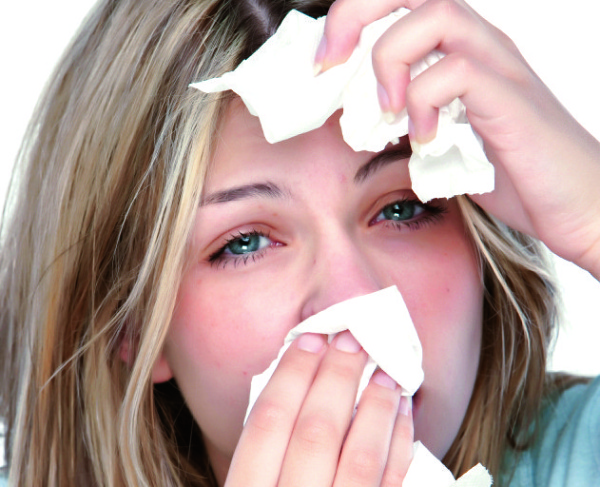Runny nose, sneezing, watery eyes: what is it?
Nature has developed protective mechanisms to remove harmful and irritating substances that enter the nasal cavity. Therefore, when a runny nose, sneezing, watery eyes occur, the body tries to get rid of damaging factors.
All three activities are interrelated and often combined. But sometimes there are isolated manifestations or only two components.
sneezing
This unconditioned reflex is inherent in us from birth and performs a protective function. The process takes a second, but several organs are involved, and a complex interaction is carried out at the level of nervous regulation for the coordinated activity of all systems.
Irritation in the nose (tickling sensation) causes a deep breath and subsequent exhalation with contraction of the intercostal muscles and diaphragm. The soft palate, the anterior pharynx and the back of the tongue isolate the oral cavity. All air under high pressure exits through the nasopharynx into the nasal cavity, removing the irritating factor, mucus, and foreign substances.
Factors that cause sneezing:
- bacteria or viruses
- allergens,
- change in air temperature,
- strong odors,
- nasal polyps,
- bright sunlight.
Runny nose
Rhinitis is an inflammation of the nasal mucosa. It manifests itself in the form of discharge from the nasal passages (serous or purulent), difficulty breathing, decreased sense of smell, sneezing.
Causes of a runny nose:
- bacteria or viruses
- allergic agents,
- vasomotor disorders (impaired vascular tone in the nasal passages),
- atrophic changes in the mucosa,
- polyps.
lacrimation
This symptom occurs when excessive formation or violation of the outflow of tear fluid. It is necessary to nourish the cornea, cleanse the eye of foreign objects (dust, specks), protect against bacteria and viruses. Fluid is removed from the eye through the nasolacrimal canal.
Causes of tearing:
- Increased tear fluid production:
- stress or pain stimuli;
- irritants (dust, bacteria, allergens);
- inflammatory eye diseases (conjunctivitis);
- pathology of the lacrimal glands.
- Violation of the outflow of tear fluid:
- swelling of the nasal mucosa and closure of the exit of the nasolacrimal passage,
- narrowing of the nasolacrimal canal.
When all symptoms occur at the same time
All things considered, runny nose, tears and sneezing appear together in two pathological conditions: allergies and viral or bacterial infections.
In the first case, inflammatory changes occur as a result of the production of histamine in response to the penetration of allergens. The reaction develops very quickly, within seconds or minutes. Sneezing and lacrimation cause great trouble and discomfort for a sick person. But for other people, such manifestations do not cause any harm, since the allergy sufferer is not contagious.

With the development of an infectious process, a runny nose and sneezing pose a threat to others, since pathogenic microorganisms are released from the nose. They spread with the ejected air to a distance of two to three meters.
With a runny nose, a serous fluid is released from the nasal passages, from which pathogenic factors are removed. They also provoke sneezing by irritating the nerve endings. And the mucosal edema disrupts the outflow from the nasolacrimal canal and causes lacrimation.
How to distinguish an infectious process from an allergy
When watery eyes and a runny nose bother you for 1-2 days, you need to see a doctor to clarify the cause and prescribe treatment. It is difficult to tell the difference between an infection and an allergy on your own.
Signs of allergic pathology:
- Spring-summer period (hay fever), but there may be year-round manifestations with allergies to dust, wool, perfumes.
- Burning and swelling of the eyelids, pronounced lacrimation.
- Deterioration of well-being when going outside (contact with an allergen).
- Moderate symptoms of intoxication (weakness, malaise).
- Good effect when using antihistamines.
Signs of an infectious process:
- autumn-winter period;
- contact with a sick person;
- cough;
- deterioration of health in the morning and evening hours;
- severe symptoms of intoxication (fever, headache, severe weakness, body aches).
Treatment
With an uncomplicated course, a cold disappears in 5-7 days. Improper treatment of allergic manifestations can delay the healing process.
Therapy of these pathologies combines the use of vasoconstrictor drugs to reduce edema and restore the patency of the nasal passages. And the second method is washing the nasal cavity to remove viruses, bacteria, allergens.
For the treatment of a viral infection, drugs that stimulate the production of interferons, antipyretics are used. When a bacterial infection develops, antibiotics are used. Given the wide variety of viruses, specific antiviral therapy has not been developed.
For the treatment of allergic manifestations, antihistamines are prescribed, in a serious condition - a course of hormone therapy. During the remission period, allergy tests are performed to identify the agent. According to the indications, immunospecific therapy is prescribed to reduce the sensitization of the body. This will reduce or prevent allergic reactions later.
Treatment of runny nose, sneezing and watery eyes depends on the underlying cause of the disease, and therapy is carried out strictly on the recommendation of the attending physician.
